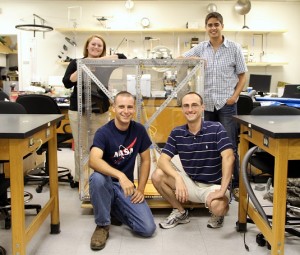Ask ACC students Natalie Misasi, Robert Feller, Garrett Hall, and Trey Black to describe their summer experience, and you’ll get some enthusiastic answers:
Natalie: “Truly incredible.”
Robert: “Wild.”
Garrett: “Mind-blowingly awesome ridiculous fun.”
Trey: “The only way I can describe it is that it’s like riding a roller coaster underwater without a
seatbelt.”
They’re talking about the feeling of weightlessness – which they experienced while flying on NASA’s “vomit comet,” a modified Boeing 727-200 that flies parabolic maneuvers over the Gulf of Mexico. As the plane descends toward Earth, riders experience microgravity and begin to float.
It’s part of NASA’s Microgravity University, a program that selects students from across the country to perform experiments during microgravity flights. NASA has chosen ACC to participate four times.
Getting the call “was exciting,” says Natalie. “It was surreal, a feeling of ecstasy.”
‘It feels like you are levitating initially. Then, with a light push off the floor, you can fly up with little effort.’ – Garrett Hall
The road to microgravity started last fall, when the team – dubbed the Austin Skyriders – began planning their experiment. The students decided to tackle the problem of muscle atrophy, which occurs in space when blood and other fluids move toward astronauts’ heads. The Austin Skyriders proposed a cradle-like device they hoped would redistribute fluids, thus reducing muscle atrophy. NASA accepted the proposal in January, and the team spent the spring and summer refining the design.
At Johnson Space Center in late July, the students met with NASA engineers to discuss the experiment and toured behind-the-scenes areas. Then came time for the flights – and to put all their hard work to the test in microgravity.
“It feels like you are levitating initially,” recalls Garrett. “Then, with a light push off the floor, you can fly up with little effort. Eventually, you can walk on walls and ceilings and do endless flips while floating through the air.”
It wasn’t just a chance to have fun. They tested their device with a blood-like substance and say it performed well.
“We are in the process of analyzing our data and writing our final report,” says Robert. “We haven’t reached a conclusion yet.”
Their advisors, Dr. Allen Underwood and Dr. Chris Haluska of the ACC Physics Department, say one outcome is certain – the value of the experience.
“They are applying skills learned in the classroom to an actual project that has checkpoints, deadlines, and major responsibilities,” says Dr. Haluska. “I hope the students are able to take away a sense of empowerment. They have the ability to compete with anyone and succeed when they apply every aspect of their education.”
Back to Top


By Kathy Barney September 10, 2014 - 5:29 pm
Congratulations on an awesome idea well executed providing an unforgettable experience and the future opening of many doors!!!